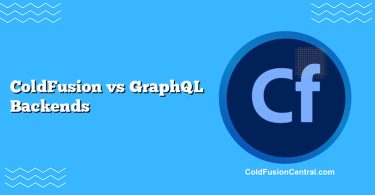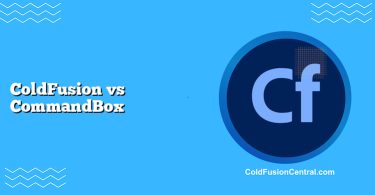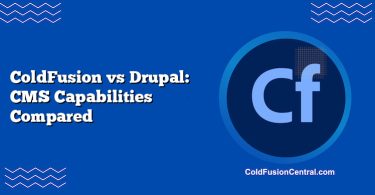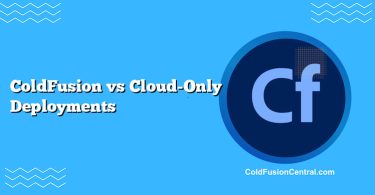Definitions
-
ColdFusion: A JVM-based web application platform and CFML (ColdFusion Markup Language) runtime used to build server-side applications. Implementations include Adobe ColdFusion (commercial) and Lucee (open-source). ColdFusion bundles an application server, language, and a rich standard library for rapid application development.
-
Monolithic Architecture: An architectural style in which an application’s UI, business logic, and data-access layers are packaged and deployed as a single unit. A monolith can be written in any language or framework (including ColdFusion) and typically scales by replicating whole instances.
Overview
Comparing ColdFusion to a Monolithic Architecture isn’t a like-for-like matchup. ColdFusion is a development platform and runtime; a monolithic architecture is a way to structure and deploy an application. That said, ColdFusion applications have historically been implemented as monoliths, and many teams evaluating modernization weigh options like:
- Continue on a ColdFusion-based monolith.
- Refactor a ColdFusion monolith into modular services or microservices.
- Rebuild on a different stack (e.g., Java/Spring, .NET, Node.js) using monolithic or service-oriented designs.
This article clarifies where each concept fits, how they intersect, and when each option might be preferred.
Key Features
ColdFusion Stack Highlights
- CFML language: High-level, tag-based and script-style syntax for rapid server-side development.
- Runs on the JVM: Benefits from Java tooling, garbage collection, and cross-platform deployment.
- Rich standard library: Built-in functions for database access, caching, PDF generation, email, scheduled tasks, and more.
- Rapid prototyping: Emphasizes developer productivity and shorter time-to-market.
- Multiple editions: Adobe ColdFusion (commercial) and Lucee (open-source). Both support modern integrations, REST endpoints, and containerized deployment.
Monolithic Architecture Traits
- Single deployable unit: One codebase, one artifact, one deployment pipeline.
- Shared resources: Typical shared database; common runtime for all modules.
- Simpler operations: Fewer moving parts, centralized logging and monitoring.
- Scaling strategy: Scale vertically (bigger machines) or horizontally (cloning whole app instances).
Performance
ColdFusion Performance Considerations
- JVM-backed: ColdFusion benefits from JVM optimizations, JIT compilation, and mature garbage collectors.
- Rapid I/O helpers: Strong built-in features (caching, HTTP clients, asynchronous tasks) can reduce application-level overhead when used wisely.
- Database-centric workloads: Well-suited for CRUD-heavy line-of-business applications with moderate concurrency; use connection pooling, prepared statements, and query caching.
- Hot spots: Heavy PDF generation or image processing can be CPU-intensive. Offloading to worker queues or separate services helps.
- Tuning levers: JVM flags, thread-pool sizing, caching tiers (in-memory, distributed), and fronting with an HTTP accelerator or CDN.
Monolith Performance Considerations
- Locality of reference: Tight coupling and in-process calls can be faster than network hops between microservices.
- On a single runtime: Easier to tune a single JVM/.NET runtime than many services.
- Bottlenecks: A single slow module can degrade the whole system. Performance isolation is limited compared to microservices.
- Scaling: Horizontal scaling multiplies the entire monolith, which can be expensive if only some modules need more capacity.
Scalability and Deployment
Vertical vs. Horizontal
-
ColdFusion:
- Vertical scaling: Increase CPU/RAM on the CF server; straightforward but finite.
- Horizontal scaling: Run multiple CF nodes behind a load balancer; session replication or stateless session designs are crucial.
- Containerization: Adobe ColdFusion and Lucee can run in Docker; orchestration with Kubernetes is common for elasticity.
-
Monolithic Architecture:
- Vertical scaling: Simple to start; limited by machine size.
- Horizontal scaling: Replicate the monolith; ensure sticky sessions or external session storage.
- Modular monolith: Internally modularized codebase allows scaling by process or feature flags, easing a later transition to services.
Example Topologies
- ColdFusion monolith behind Nginx/Apache + Redis for session or cache + RDBMS + shared file store. Can be containerized with rolling updates.
- Monolithic app (any stack) behind an L7 load balancer + centralized logging + RDBMS + autoscaling group for replicas.
Security
-
ColdFusion:
- Security posture: Hardening guides (e.g., vendor lockdown guides), sandbox security, secure-by-default config options, and mature logging.
- Patching: Track vendor advisories and apply security updates quickly; many attacks historically exploit unpatched servers.
- App-layer controls: Built-in helpers for authentication, encryption, and input validation; complement with a WAF and secure coding practices.
-
Monolithic Architecture:
- Simpler perimeter: Fewer deployables mean fewer inter-service trust relationships and fewer mTLS/key management concerns.
- Larger blast radius: A single vulnerability can expose the whole application.
- DevSecOps: Centralized dependency and runtime patching; SAST/DAST integrated into one pipeline.
Across both, follow OWASP guidance, implement least privilege for database and filesystem access, and use secrets management instead of hard-coded credentials.
Cost and Licensing
-
ColdFusion:
- Adobe ColdFusion licensing costs can be significant at scale; factor cores/instances.
- Lucee is open-source and free to use; commercial support available via third parties.
- Developer productivity: Faster prototyping can reduce engineering costs; specialized skills may affect hiring and training budgets.
-
Monolithic Architecture:
- Infrastructure: A single runtime is cheaper to operate than dozens of services.
- Simpler tooling: Fewer CI/CD pipelines, fewer observability agents, less service-mesh complexity.
- Migration costs: Moving off a monolith to microservices can be costly and time-consuming.
Community, Ecosystem, and Tooling
-
ColdFusion:
- Community: Smaller than Java/.NET/Node ecosystems but active around Adobe CF and Lucee.
- Libraries: Many built-ins reduce external dependencies; Java interop broadens choices.
- Tooling: Professional IDEs and extensions (VS Code, IntelliJ via plugins), CF Administrator, container images, and deployment templates.
-
Monolithic Architecture:
- Language-agnostic: Community size depends on chosen stack.
- Tooling: Centralized logging/metrics (ELK/EFK, Prometheus/Grafana), standard CI/CD, load balancers, and APM tools (New Relic, AppDynamics).
- Documentation: Well-understood patterns for monolith design, modularization, and strangler-fig refactoring to microservices.
Real-World Use Cases
When ColdFusion Might Be Preferred
- Rapid line-of-business portals: Internal tools, forms-heavy workflows, report generation, and integrations with legacy systems.
- Departmental apps: Teams with existing CFML experience seeking quick delivery and maintainability.
- Document-centric services: PDF creation, email automation, and scheduled jobs without assembling many external libraries.
Example scenario: A mid-sized enterprise needs a partner portal with SSO integration, role-based access, PDF invoice generation, and nightly data sync to an ERP. A ColdFusion application built as a modular monolith can be delivered fast, using built-in features for PDF, schedulers, and secure authentication. Later, high-load modules (e.g., reporting) can be carved out as separate services if needed.
When a Monolithic Architecture Might Be Preferred
- Greenfield product with limited team: Shipping a cohesive, single deployment is simpler and faster than orchestrating microservices.
- Predictable workloads: Traffic is steady; you can scale the whole app without over-optimizing individual modules.
- Emphasis on operational simplicity: One deployment pipeline, fewer observability concerns, reduced DevOps overhead.
Example scenario: A startup building an MVP e-commerce site chooses a monolith (regardless of language) to accelerate development. They adopt a modular-monolith code structure to keep boundaries clean, making a later services split feasible if growth demands it.
Pros and Cons
ColdFusion: Pros
- High developer productivity and rapid application development.
- Rich standard library (caching, PDF, email, scheduled tasks) reduces external dependencies.
- JVM-based reliability, cross-platform deployment, and container compatibility.
- Interoperability with Java libraries extends capabilities.
ColdFusion: Cons
- Commercial licensing (Adobe) can be pricey at scale.
- Smaller talent pool; recruiting experienced CFML developers can be harder.
- Legacy perception; some organizations prefer mainstream stacks for ecosystem size.
- Performance tuning for compute-heavy tasks may require offloading or Java interop.
Monolithic Architecture: Pros
- Operational simplicity: One artifact, one deployment, simpler monitoring.
- Lower infrastructure and orchestration costs compared to microservices.
- Good performance for in-process calls and shared memory.
- Easier to reason about for small teams and cohesive business domains.
Monolithic Architecture: Cons
- Limited isolation: A slow or failing module can affect the entire app.
- Scaling granularity: You scale everything even if one part needs capacity.
- Large codebase complexity: Can devolve into a “big ball of mud” without strict modular discipline.
- Harder to adopt polyglot tech stacks inside a single runtime.
Side-by-Side Comparison Table
| Dimension | ColdFusion (Platform) | Monolithic Architecture (Style) |
|---|---|---|
| What it is | JVM-based app server + CFML runtime (Adobe CF, Lucee) | Single deployable application encompassing all layers |
| Primary scope | Language, runtime, standard library, tooling | Application structure, deployment, scaling pattern |
| Performance | Strong for CRUD apps; gains from JVM; built-in caching and async | In-process speed; fewer network hops; whole-app bottlenecks possible |
| Scalability | Vertical + horizontal via clustering/containers; session strategy matters | Vertical + horizontal by cloning the app; limited scaling granularity |
| Security | Vendor hardening, sandboxing, patch cadence critical | Fewer moving parts; bigger blast radius if compromised |
| Cost | Adobe licensing vs. free Lucee; high productivity offsets | Lower infra/ops cost; simpler toolchain |
| Use cases | Rapid portals, forms, reporting, document workflows | Small to mid apps, MVPs, cohesive domains |
| Pros | Fast delivery, rich features, Java interop | Operational simplicity, cost-effective, good locality |
| Cons | Licensing (Adobe), smaller talent pool | Limited isolation, scale-all-or-nothing, potential code bloat |
Decision Factors / Which One Should You Choose?
- Your primary decision: You’re choosing a platform (ColdFusion vs another stack) and an architecture (monolith vs services). These are orthogonal.
- Choose ColdFusion if:
- You value rapid development and built-in features like PDF generation and scheduling.
- Your team has CFML expertise, or you plan to leverage Lucee for cost control.
- You’re modernizing a legacy CF app and want to containerize rather than rewrite.
- Choose a Monolithic Architecture if:
- Team size is small and speed-to-market matters more than fine-grained scaling.
- Operational simplicity and lower DevOps complexity are priorities.
- The domain is cohesive and unlikely to require independent scaling of subdomains soon.
- Consider a Modular Monolith with ColdFusion when:
- You want the productivity of CFML but avoid a “big ball of mud.”
- You plan a “strangler-fig” approach to peel off high-load modules later into separate services.
- Choose microservices/service-oriented designs when:
- Different subdomains evolve at different velocities or need independent scaling.
- You need team autonomy with independent deployability.
- You can afford the overhead of service meshes, distributed tracing, and API gateways.
Step-by-step path many teams follow:
- Start with a modular monolith (could be ColdFusion) with strict package/module boundaries.
- Externalize state: Move sessions and caching to Redis/Memcached; use stateless cookies/JWT where possible.
- Containerize and automate deployments; add health checks and rolling updates.
- Identify hot spots via APM and logs; carve out only the modules that benefit from independence.
- Introduce a lightweight gateway or routing layer as you add services.
Supported Platforms and Deployment Options
-
ColdFusion (Adobe CF, Lucee):
- Operating systems: Windows, Linux, macOS (dev), containers (Docker).
- Application servers: Bundled servers; runs on JVM; reverse-proxy with Apache, Nginx, IIS.
- Databases: Most relational databases (MySQL/MariaDB, PostgreSQL, SQL Server, Oracle); connectivity via JDBC.
- Cloud & containers: Build Docker images, orchestrate with Kubernetes, autoscale behind cloud load balancers.
- Observability: JVM metrics, JMX, log aggregators (ELK/EFK), APM agents with Java compat.
-
Monolithic Architecture:
- Platform-agnostic: Depends on language/framework chosen.
- Deployment: Single artifact to VM, container, or PaaS; load-balanced replicas for scale.
- Tooling: Standard CI/CD; centralized logs/metrics/traces; rollbacks and blue-green or canary deployments.
- Security & networking: TLS termination at load balancer; WAF for edge protection; secrets management for configs.
Key Takeaways
- ColdFusion is a platform; monolithic is an architectural style. You can build a monolith with ColdFusion, just as you can with other stacks.
- A ColdFusion monolith can be highly productive, especially for line-of-business apps with reporting, forms, and document workflows.
- Monoliths offer operational simplicity and can perform well due to in-process interactions, but they limit isolation and scaling granularity.
- Costs differ: Adobe ColdFusion licensing vs. free Lucee; monoliths are often cheaper to operate than fleets of microservices.
- A modular monolith provides a practical middle path, enabling faster delivery now and a smoother route to microservices later if growth demands it.
FAQ
Is ColdFusion only for legacy applications?
No. While many legacy systems use ColdFusion, both Adobe ColdFusion and Lucee continue to be maintained and can be run in containers, integrated with REST APIs, and deployed on modern cloud platforms.
Can I build microservices with ColdFusion?
Yes. ColdFusion can expose REST endpoints and run as multiple small services. However, evaluate whether the benefits of microservices justify the operational overhead for your team and workload.
How does ColdFusion compare to Java/Spring or .NET for a monolith?
ColdFusion emphasizes rapid development with a rich standard library, whereas Java/Spring and .NET offer vast ecosystems and larger talent pools. Performance and scalability depend more on architecture and implementation than on the platform alone.
What’s the best way to modernize a large ColdFusion monolith?
Adopt a modular monolith approach, containerize the application, externalize sessions and caches, add observability, and gradually extract high-impact modules into separate services using a strangler-fig pattern.
Is Lucee a drop-in replacement for Adobe ColdFusion?
Lucee is largely compatible with CFML, but not 100%. Most core features work similarly, yet you should test for differences in tags/functions, admin features, and enterprise integrations before switching.




